| Botanical Name |
|
| Family |
Solanaceae - The nightshade or potato family |
| Pronunciation |
|
| Common Name(s) |
English: Honey-thorn; Wolfthorn
|
| Plant Group |
- Shrub A woody plant of relatively low height, having several stems arising from the base and lacking a single trunk; a bush.
|
| Plant Size |
- Large
| Tree | 18m to 25m |
| Shrub | 3m to 4m |
| Perennial/ground cover | 75cm to 1m |
| Bulb | 80cm to 1.2m |
| Succulent | 1m to 1.5m |
- Medium to Large
| Tree | 15m to 20m |
| Shrub | 2m to 3m |
| Perennial/ground cover | 60cm to 75cm |
| Bulb | 60cm to 1m |
| Succulent | 60cm to 1m |
|
| Position |
- Canopy Shade Canopy shade is found below closely grown trees where some light filters through. Ideal for the protection of herbaceous plants.
- Light or Dappled Shade Found below trees with sparse, open foliage. Ideal for the protection of herbaceous plants.
- Partial Shade The area is in shade for part of the day and in full sun for part of the day.
- Sun The area is in full sun for all or most of the day, all year round.
|
| General Information |
- Attractive fruits, berries or seeds Brightly coloured fruits or berries increase and extend the visual impact of the plant and are especially attractive to birds and other small wildlife.
- Deciduous to Semi-deciduous In warmer areas a deciduous plant may not lose its leaves during winter at all, or may lose its leaves for a very brief period, or may only lose part of its foliage.
- Drought Tolerance: High The plant is well adapted to arid conditions; it can survive long periods of drought and high temperatures without extra water.
- Frost: Hardy The plant can withstand freezing temperatures or frost without artificial protection.
- Thorns / Spines / Prickles Thorn: A hard, woody, pointed branchlet.
Spine: A modified leaf forming a hard, sharp-pointed outgrowth.
Prickle: A small, sharp-pointed outgrowth growing from the bark of the plant.
- Water Wise Plant species originating from low rainfall regions that require less water to survive and thrive than other plant species.
- Wind Tolerant Plants able to withstand the effect of strong winds.
|
| Specific Information |
Lycium oxycarpum is a long-lived, much branched shrub to small tree, with curving, rigid, spiny branches. The narrow, yellowish-green leaves may be grouped or spirally arranged, and are found growing on branches, branchlets and on the spines. The Honey-thorn is reportedly summer dormant in very dry areas or during severe drought. The fruits ripen to a bright orange-red and appear shortly after the flowers. The fruits are oblong-shaped berries with numerous small, flattened seeds and are much sought after by birds.
|
| Ad Break |
|
| Flowers |
| Description |
a slender cream coloured tube opening out with 5 rounded mauve lobes
|
| Season |
- Winter to Spring Plants will seldom bloom for the entire season as given in the list, but should flower during a period within these parameters.
|
| Colour |
|
| Growth Rate |
- Moderate to Fast Specifying growth rate can be very misleading as there is considerable variation of growth rate depending on type and species of plant, available water, supplementary feeding, mulching and general care, as well as the plants suitability and adaptability to the garden environment.
|
| Plant Uses |
- Attracts bees, butterflies or other insects This plant attracts insects which can be food for birds or other creatures in your garden.
- Attracts Birds This plant will attract birds.
- Barrier Plant A very thorny shrub, tree or scrambler that can be used to create an impenetrable barrier.
- Boundary A plant useful for planting around the edges of the property to form a green or colourful backdrop, an impenetrable hedge, to hide walls or create privacy.
- Filler Either a fast growing tree or shrub used temporarily to fill in an area while the permanent plants grow to a desired size, or a plant used to fill gaps in borders or beds.
- Hedge Suitable trees or shrubs planted relatively close together so that the branches intertwine to create a barrier. This can be formal – the plants are regularly trimmed to produce a neat shape, or informal – the plants are left to themselves to create a natural hedgerow.
- Suitable for coastal gardens Plants adapted to dry, sandy soil, forceful wind, limited rainfall and intense sunlight.
- Wild Garden An indigenous garden planted for the benefit of wildlife and birds. Provides food, water, a variety of mini-biomes and no poisonous chemicals are used.
- Windbreak Trees planted in a row to form protection from prevailing winds by breaking the force of the wind, thereby reducing wind damage.
|
| Distribution and Habitat |
widely spread in the Eastern Cape, Northern Cape and Western Cape, with small populations in the Free State and Namibia, in hot, dry karoo scrub, in Acacia karoo woodland, in drainage areas and at the bottom of valleys
|
| Planting Suggestions |
Plant in well-drained soil mixed with some compost. Mulch around the shrub and water weekly until established. Watering can then be steadily reduced until the plant is able to rely on rainfall alone. For faster growth continue supplementary watering, and add a yearly dressing of compost, general fertiliser and mulch.
|
| Lorraine's Garden Notes |
2012 November:
Seeds planted 3 - 4 weeks ago germinating well. One of three cuttings has rooted.
|
| Medicinal Uses |
In Namibia the roots of young shrubs are used for backache, diseases of the male genitalia, painful and excessive menstruation, diarrhoea in children and as a purgative.
No data found for use in South Africa.
|
| Ad Break |
|




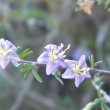
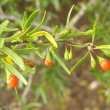
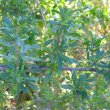
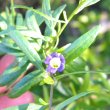
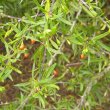
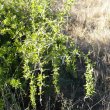


Discuss this plant
Share knowledge, ask a question or give an experience.